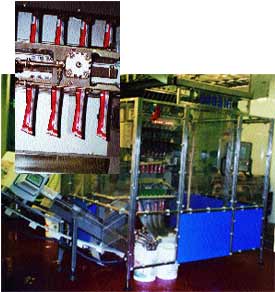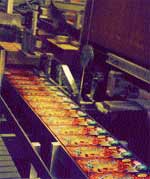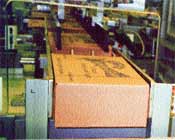Putting a squeeze on efficiency
January 29, 2014
As is evidenced by childbirth, nine months can make a tremendous difference. For example, it can demonstrate that major progress may come in well-considered moves, rather than in huge steps.
Stonyfield Farm supports this approach. Rethinking its needs for the packaging line in its Londonderry, NH, plant for its enormously popular, all-natural low-fat YoSqueeze™ yogurt in tubes, Stonyfield is starting to enjoy the satisfaction that comes with reducing operating strain while doubling production and halving the staff needed to do the job.
And, it has accomplished this in just nine months. Completed in April, the restructuring of its original line for the product, onstream only since the previous August, is translating into a reliable 400-tube/min output. This compares with the initial 200-tube/min and interim 320-tube/min speed before the recent changes, operations vp John E. Daigle informs PD during a visit last month.
|
A survivor of the original packaging line, an eight-station f/f/s machine warm-fills 2-oz shots of product, which then convey up an incline and through a metal detector. |
Functioning in approximately the same horseshoe-shaped space needed for the original line, the reborn equipment lineup places greater efficiency toward its foot. There, Elliott Manufacturing's newest continuous-motion cartoner and case packer are bringing a higher degree of automation to the operation with half the number of operators originally needed.
Seeming the same but with subtle differences resulting from processing changes, the finished packages perform as well as ever. The most notable changes are the dry cartons that can be refrigerated or frozen by the consumer.
These are the outgrowth of a change after the tubes are formed and filled on Hassia's SVL 20/30 Stick Pack form/fill/seal machine, at the original line's start. Rated to 100 cycles/min, the machine is structured for eight-up output. The warm-filled sticks are 2-oz sachets formed of film made by Curwood of 48-ga polyester, reverse-printed via flexography in four line and three process colors and extrusion-laminated to 1.75-mil low-density polyethylene (see PD, June '01, p. 38). Consumer-convenient is the integral butt-seal tape Curwood produces of 48-ga polyester/11/2-mil LDPE.
On the day of PD's stay, the f/f/s machine is filling two YoSqueeze flavors, Rocket Raspberry and Planetary Punch, on a four-up basis for each variety, for loading into eight-tube cartons. Another flavor, in a remarkably quick changeover, is Very Berry Blast. The other flavors are Strawberry Stratosphere and Cherry Eclipse.
Before, Stonyfield operations control manager Steve Inamorati explains, the filled tubes would flow through an ice water bath that would chill them prior to cartoning. "The trouble is, even with some dwell after coming out of the bath, the tubes would be damp afterward. We even had people drying them, though the cartons are coated and are strong enough to withstand the moisture. And, the cartoning was a manual operation, with automated sealing, so we could observe any problems that might come up." For the entire YoSqueeze series of five flavors–now certified organic–the glued-end cartons are made of .018 solid unbleached sulfate, produced by Old Dominion, which prints them via offset in five colors and applies an aqueous coating.
Throwing out the bother with the bathwater, the line now has a smooth, segmented, motorized conveyor as the tubes ascend an incline that passes them through a Safeline metal detector and over an Ishida DACS checkweigher supplied with the cartoner. With all of the acceptable tubes feeding eight-up into the partitioned Uni-Pak conveyor, the new regime begins.
Hands-off operation
Removing the ice water bath, Stonyfield takes line workers' hands off with installation of Elliott's CH-2 continuous-motion cartoner. With an overhead horizontal magazine feed activated by a Piab photoelectric eye and all downstream functions handled by Allen-Bradley's SLC 504 programmable logic controller, the blanks are lifted from the magazine by suction placers that partially open them and time them onto the Uni-Pak conveyor.
|
Cartons, coded, side-loaded and end-sealed with hot-melt adhesive, convey past the spot once needed for an ice water bath, and then move downstream to a recently installed cooler. |
Pusher plates move the tubes laterally into the cartons, which receive shots of National Starch hot melt from Nordson applicators. For this machine, positive transfer is assured by front and rear flight lugs. At this point, too, they receive date and lot codes on their rear panels from a Markem 9064S ink-jet coder.
The sealed cartons move downstream to the refurbished chiller that now assumes the job of the ice water. With a 60- to 90-min cycle, the chiller is the packaging line's turnaround point. Exiting cartons convey in a straight line to case packing.
With its custom infeed system, including front lugs and a servo- driven product loader, the 2000SL case packer is described by builder Elliott Manufacturing as a "three-in-one" machine. It erects, loads and seals in a small footprint corrugated blanks that are also customized for Stonyfield. These are side-loading RSCs, with about a 2-in. overlap, that Smurfit Stone produces of 32-ECT C-flute, flexo printing them in blue with the brand graphics.
|
Cartons are collated and side-loaded into specially modified corrugated blanks that feed from an oversized magazine, further reducing manual involvement. |
The fully automated machine collates and loads eight cartons into each shipper following opening and end-gluing with a National Adhesives hot melt by a Nordson applicator, as with the cartoner. This is repeated at the sealing station, and the completed box is lug-ejected for manual off-loading onto a roller conveyor for travel past Loveshaw's Little David Microjet ink-jet coder on the way to palletization. The case packer's rated output is 20/min, which is a good speed for the company's needs, Steve Inamorati comments.
Explaines John Daigle, "We're pretty pleased with the modified line's performance. Before July we were able to keep up with demand, since this is a relatively new product. But then came the 'organic' certification, which may bring the brand into many additional outlets.
"It seems that we made the equipment changes at just the right time. We're currently meeting demand with a one-shift day that involves three to four people, compared with the original eight. It wouldn't be any problem to go into a second shift. We're ready for higher demand."
He should be, with a line that flows as smoothly as yogurt.
More information is available:
Cartoner/caser: Elliott Manufacturing, 559/233-6235. Circle No. 221.
F/f/s machine: Hassia USA, 732/536-8770. Circle No. 222.
Film: Curwood, 800/544-4672. Circle No. 223.
Carton: Old Dominion, 847/342-8760. Circle No. 224.
Metal detector: Safeline, 800/447-4439. Circle No. 225.
Conveyor: Uni-Pak Corp., 407/830-9300. Circle No. 226.
Checkweigher: Heat and Control, Inc., 800/227-5980. Circle No. 227.
Photoelectric eye: Piab Vacuum Products, 800/321-7422. Circle No. 228.
PLC: Allen-Bradley, 414/382-2000. Circle No. 229.
Adhesive: National Starch & Chemical Co., 800/797-4992. Circle No. 230.
Adhesive applicators: Nordson Corp., 440/985-4226. Circle No. 231.
Coder: Markem Corp., 800/421-9698. Circle No. 232.
Shipper: Smurfit Stone Container Corp., 888/801-2579. Circle No. 233.
Coder: Loveshaw, an ITW co., 800/572-3434. Circle No. 234.
About the Author(s)
You May Also Like





